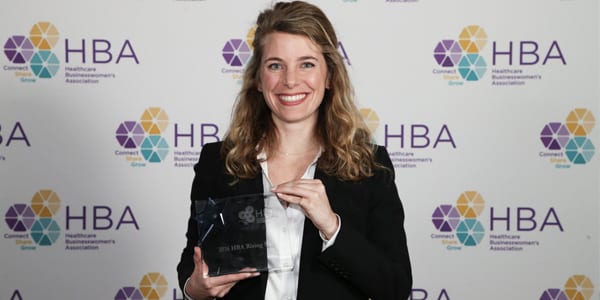 I recently had the privilege of joining a select group of women from around the world to celebrate a shared mission: furthering the advancement and impact of women in the business of healthcare. While the Healthcare Businesswomen’s Association (HBA) Woman of the Year event, and activities leading up to it, were charged with a palpable excitement, for me the greatest sentiment was that of connectedness. Were those celebrated as Rising Stars noticeably happy to be there and clearly grateful for a reprieve from their day-to-day in exchange for clinking champagne glasses? Absolutely. But more than this, as I made my way to meet the members of this new community, I took the opportunity to consider what role our collective work plays in the greater world.
I recently had the privilege of joining a select group of women from around the world to celebrate a shared mission: furthering the advancement and impact of women in the business of healthcare. While the Healthcare Businesswomen’s Association (HBA) Woman of the Year event, and activities leading up to it, were charged with a palpable excitement, for me the greatest sentiment was that of connectedness. Were those celebrated as Rising Stars noticeably happy to be there and clearly grateful for a reprieve from their day-to-day in exchange for clinking champagne glasses? Absolutely. But more than this, as I made my way to meet the members of this new community, I took the opportunity to consider what role our collective work plays in the greater world.
Each day, as a communications professional working in the healthcare industry, I find myself blissfully – and, admittedly, sometimes exhaustedly – reminded that we work in a field that demands constant learning. It’s emotional and factual, limitless yet finite, nimble but nonnegotiable. We navigate these often paradoxical truths on behalf of our clients, carving out the right paths that can clearly share their story without losing sight of the complex issues they solve for, or human needs of those often on the receiving end of a glut of information.
The duties of a communications professional often comes at the tail end of the years (sometimes decades) of preceding work, work no doubt done by the HBA women with whom I shared the stage. I was very much reminded of this while being surrounded by women from a range of healthcare professions: researchers, investor relations managers, maternal health specialists, clinicians, sales directors, lawyers, clinical trial designers. Their brilliant minds each play a vital role in the work we do, and we have the amazing privilege of telling the story of what their years of effort has achieved to patients, providers, investors, advocates, policymakers and influencers.
These women make the proverbial engine run. And as the baton is passed to professionals like myself to step in and play our part, we have a great responsibility in communicating the purpose and outputs of their journeys.
So, how do we deliver on this charge to break through the info glut and uncertainty?
- Get cozy with the science.
This constant learning and need to stay as ahead of the curve as possible comes to life across the industry. For scientists, they are challenged to innovate, solve and improve; for communications professionals we must be at the forefront of the news, lead the conversation and balance clear education with eye-catching content. To do this, we read the latest studies and get to know the science. It’s not about one abstract data point or report, but what it means in the larger context of that therapeutic category or for healthcare systems as a whole. When we understand the scientific and clinical landscape, we can tell more thoughtful and compelling stories.
- Remember the audience.
Sometimes in scientific communications, professionals lose sight of the impact for the sake of explaining the data. At the receiving end of our communication is always a person, whether it’s a prescribing physician, patient advocate or policymaker – they have a pulse and play an important decision-making role. Always seek to answer the questions, “What does this mean, and why does it matter?“
- Get your vision back.
It can be tricky to find the most compelling way to tell a scientific story when the information you have is all about methodology, data, results and conclusions. Whether the study is blinded or not, it feels so far removed from the people it is meant to impact. Get your perspective back and always consider the patient populations involved. Healthcare is personal for everyone, and if we keep the patient and their personal ecosystem at the center throughout our communications, we can authentically humanize the work we do while effectively communicating our priority messaging.
I feel fortunate to have so many women paving new paths and championing each others’ successes at Ketchum. And, similar to my experience at the Healthcare Businesswomen’s Association, among these women are great men, who also function as role models, mentors, sponsors and advocates for the next generation of healthcare communications professionals. During the Woman of the Year event, a speaker likened the issue of gender parity in the workforce to the roads we drive on every day: these roads were initially designed for cars, and are largely an immoveable part of our ecosystem. If we think about the introduction of bicycles to these same roads, we can develop laws and rules for the road to protect a rider’s rights and safety. And, while these rules may be fair, the roads are not. Like gender parity in the workforce, it is a systemic problem. We have to invest in building new roads rather than paving over the old ones.